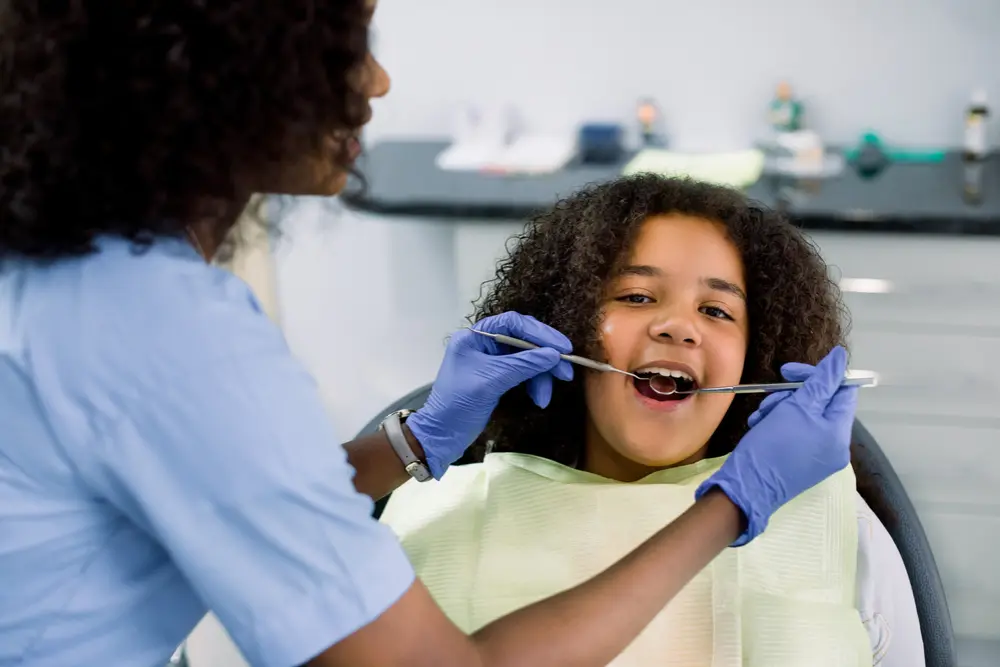Pediatric Dentist: Ensuring Your Child’s Dental Health
Outline

- Introduction
- Importance of Pediatric Dentistry
- Overview of the Role of a Pediatric Dentist
- What is Pediatric Dentistry?
- Definition and Scope
- Differences Between Pediatric and General Dentistry
- The Role of a Pediatric Dentist
- Specialized Training and Education
- Key Responsibilities
- Why Choose a Pediatric Dentist for Your Child?
- Benefits of Specialized Care
- Understanding Child-Specific Dental Needs
- When to Visit a Pediatric Dentist
- Recommended Age for First Visit
- Signs Your Child Needs to See a Dentist
- Common Pediatric Dental Issues
- Tooth Decay
- Thumb Sucking
- Teething Problems
- Dental Anxiety
- Preventive Dental Care for Children
- Importance of Early Prevention
- Tips for Maintaining Oral Health at Home
- Dental Treatments Offered by Pediatric Dentists
- Fillings and Crowns
- Fluoride Treatments and Sealants
- Orthodontic Assessments
- Making the Dental Visit Comfortable for Kids
- Creating a Child-Friendly Environment
- Techniques to Ease Anxiety
- Educating Parents and Children
- Importance of Oral Hygiene Education
- Resources and Tools Provided by Pediatric Dentists
- Pediatric Dental Emergencies
- Handling Dental Trauma
- When to Seek Immediate Care
- Choosing the Right Pediatric Dentist
- Factors to Consider
- Questions to Ask During the First Visit
- Cost and Insurance Considerations
- Understanding Insurance Coverage
- Budgeting for Pediatric Dental Care
- Future Trends in Pediatric Dentistry
- Advances in Technology
- Emerging Treatments and Practices
- Conclusion
- Recap of Key Points
- Encouragement for Regular Dental Visits
- FAQs
- How often should my child visit a pediatric dentist?
- What should I do if my child is afraid of the dentist?
- Are dental X-rays safe for children?
- How can I prevent cavities in my child’s teeth?
- What should I look for in a pediatric dentist?
Pediatric Dentist: Ensuring Your Child’s Dental Health
Introduction
As parents, ensuring our children’s health is always a top priority, and dental health is no exception. Pediatric dentistry plays a crucial role in maintaining and improving your child’s oral health from infancy through the teenage years. But what exactly does a pediatric dentist do, and why should you consider one for your child? Let’s dive into the world of pediatric dentistry and explore its many facets.
What is Pediatric Dentistry?
Pediatric dentistry is a specialized branch of dentistry that focuses on the dental health of children from birth through adolescence. Unlike general dentistry, which caters to patients of all ages, pediatric dentistry is specifically designed to address the unique dental needs of younger patients. This includes everything from preventive care and education to more complex treatments.
The Role of a Pediatric Dentist
Pediatric dentists undergo additional training beyond dental school, typically including a residency program focused on the dental needs of children. This specialized training equips them with the skills needed to handle a wide range of issues specific to young patients. Their key responsibilities include:
- Conducting routine check-ups and cleanings
- Diagnosing and treating dental issues such as cavities and gum diseases
- Educating parents and children about proper oral hygiene
- Providing preventive treatments like fluoride applications and sealants
- Managing dental emergencies and trauma
Why Choose a Pediatric Dentist for Your Child?
Choosing a pediatric dentist for your child comes with several benefits. Pediatric dentists understand the unique challenges and anxieties that children may face during dental visits. They are trained to make the experience as comfortable and stress-free as possible, using child-friendly techniques and creating an environment that puts young patients at ease. Additionally, they have a deep understanding of the developmental stages of children’s teeth and jaws, enabling them to provide more effective and targeted care.
When to Visit a Pediatric Dentist
It’s recommended that your child visits a pediatric dentist by their first birthday or within six months after their first tooth emerges. Early visits help establish a dental home and allow the dentist to monitor your child’s oral development from the start. Signs that your child needs to see a dentist include:
- Tooth pain or sensitivity
- Difficulty chewing or speaking
- Persistent bad breath
Common Pediatric Dental Issues
Several dental issues are particularly common among children. These include:
- Tooth Decay: The most prevalent chronic disease among children, often caused by poor diet and oral hygiene.
- Thumb Sucking: While normal in infants, prolonged thumb sucking can affect the alignment of the teeth and jaws.
- Teething Problems: Teething can be uncomfortable for babies, leading to symptoms like irritability and gum swelling.
- Dental Anxiety: Many children experience fear or anxiety about dental visits, which can hinder proper dental care.
Preventive Dental Care for Children
Preventive care is crucial in pediatric dentistry. Early prevention helps avoid many common dental issues and sets the foundation for a lifetime of healthy teeth. Here are some tips for maintaining your child’s oral health at home:
- Brush your child’s teeth twice a day using a toothpaste containing fluoride.
- Limit sugary snacks and drinks.
- Encourage regular dental check-ups.
Dental Treatments Offered by Pediatric Dentists
Pediatric dentists provide a range of treatments to address various dental issues:
- Fillings and Crowns: Used to repair cavities and damaged teeth.
- Fluoride Treatments and Sealants: Preventive treatments that strengthen enamel and protect against decay.
- Orthodontic Assessments: Early evaluations to determine if braces or other corrective measures are needed.
Making the Dental Visit Comfortable for Kids
Creating a positive dental experience is essential. Pediatric dentists employ various techniques to ease anxiety, such as:
- Designing the office with a child-friendly atmosphere, including toys and colorful decor.
- Using gentle and reassuring language to explain procedures.
- Offering sedation options for more anxious patients.
Educating Parents and Children
Education is a cornerstone of pediatric dentistry. Pediatric dentists provide valuable resources and tools to help parents and children understand the importance of oral hygiene. This includes:
- Show how to brush and floss correctly.
- Nutritional advice to promote healthy teeth.
- Information on what to expect during different stages of dental development.

Pediatric Dental Emergencies
Urgent dental situations can be alarming for both kids and parents. Common emergencies include:
- Tooth Injury: Including a dislodged or broken tooth.
- Severe Tooth Pain: This could indicate an infection or abscess.
- Swelling or Bleeding: That doesn’t subside with basic first aid measures.
Knowing how to handle these situations and when to seek immediate care is crucial for minimizing damage and ensuring your child’s comfort.
Choosing the Right Pediatric Dentist
Selecting the right pediatric dentist involves several considerations. Look for a dentist who:
- Has specialized training and certification in pediatric dentistry.
- Creates a welcoming and child-friendly environment.
- Speak clearly and helpfully with both you and your child.
- Is experienced in handling children with dental anxiety or special needs.
Cost and Insurance Considerations
Understanding the cost of pediatric dental care and your insurance coverage can help you plan effectively. Most insurance plans cover basic preventive care, but it’s important to know what additional treatments might cost. Discussing fees and payment plans with your dentist can help you budget accordingly.
Future Trends in Pediatric Dentistry
The field of pediatric dentistry is continuously evolving with advancements in technology and treatment methods. Emerging trends include:
- Laser Dentistry: Less invasive and more comfortable for children.
- Tele-dentistry: Virtual consultations and follow-ups.
- Biomimetic Materials: Used for more natural and durable dental restorations.
Conclusion
Pediatric dentistry is a vital aspect of your child’s overall health and well-being. By choosing a specialized pediatric dentist, you ensure that your child receives the best possible care tailored to their unique needs. Regular dental visits, preventive care, and a positive attitude towards oral hygiene can set your child on the path to a lifetime of healthy smiles.
FAQs
How often should my child visit a pediatric dentist? It’s recommended that children visit a pediatric dentist every six months for routine check-ups and cleanings.
How should I handle my child’s fear of the dentist? Try to choose a pediatric dentist who specializes in handling dental anxiety. Preparing your child by explaining what to expect and staying calm can also help alleviate their fears.
Are dental X-rays safe for children? Yes, dental X-rays are safe for children. Pediatric dentists use low-radiation X-rays and take necessary precautions to ensure your child’s safety.
How do I stop my child from getting cavities? Encourage regular brushing and flossing, limit sugary foods and drinks, and ensure your child receives fluoride treatments and dental sealants.
What qualities should I seek in a pediatric dentist? Look for a dentist with specialized training, a child-friendly office environment, effective communication skills, and experience with children who have dental anxiety or special needs.
